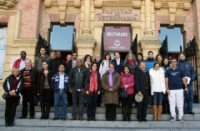A new method to characterize pathogen contamination in pork meat
Escrito porFundación Descubre
This technique, based on mathematical calculations, enables definition of optimal storage temperature for these products, with the aim to avoid appearance and development of microorganisms such as Salmonella or Listeria monocytogenes.
Andalusian Engineers and Surgeons develop the first Spanish surgical robot with 3D vision
Escrito porG.C.- E.L.
An Andalusian team of engineers and surgeons, mostly from Córdoba, is working on the development of the first Spanish surgical robot prototype with 3D vision, which successfully passed a first demonstration. This equipment will provide significant advantages over traditional laparoscopic systems thanks to its innovative technological specifications and results from collaboration between public sector and private enterprise.
Development of a new method to analyze authenticity of vinegar
Escrito porFundación Descubre
This technique allows examination of vinegar properties and with lower cost of the quality control process
A sensor to analyze Iberian pig authenticity in real time
Escrito porG.C.-E.L.
Researchers from the School of Agricultural and Forestry Engineering (ETSIAM) at the University of Córdoba have developed several applications for real time determination of food profuct quality and authenticity in sectors such as Iberian pork and fruit and vegetables. For this, experts used portable spectral sensors based on NIRS technology, which is based on a relationship between spectral measurements and physical and chemical parameters in food and allows instant, nondestructive analysis of different product samples, such as loin, ham, plums, asparagus or orange.
El proyecto COMET-LA, seleccionado para debatir el futuro de Europa como un actor global
Escrito porG.C. - E.L
La investigadora de la Universidad de Córdoba y el ceiA3 María del Mar Delgado expondrá en Bruselas la experiencia acumulada por el proyecto en la gestión participativa y ascendente de recursos naturales
G.C.-E.L.
A work of veterinarians from the Agrifood Campus of International Excellence ceiA3 at the University of Córdoba achieved international recognition in the 31st Meeting of The European Society and College of Veterinary Pathologists held in London


